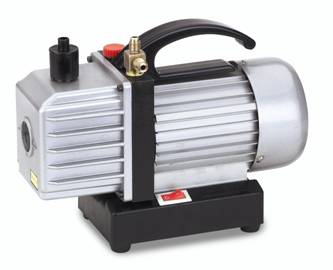if you have had a leak and the system is empty you first need to find out where the leak is or you will be wasting time and money.
Look for oily spots like the front clutch area of the compressor and all fittings. Once you find the leak and fix it, then you will need a deep vane vacuum pump and a set of manifold guages to do the work(whether you convert or not).
Autozone in my town has both for use under the tool loan program. You just leave a deposit and get you money back when you return the tools.
here is the order in which you need to fix your A/C
1. Find the leak and fix it
2. install the retrofit kit, first try to drain as much of the old mineral oil out as you can, usually if you can get the lower connection off of the condenser enough will drain out. the kit is just basically a few ozs of compatible oil and new fittings that are quick connects and a label letting others know it has been converted. If you break any connection, go back with a new o-ring!!
3. Hook up the vacuum pump with the guages and pull a deep vauum on the system. This removes moisture and test your repair and overall system for leaks. You should be able to get nearly 30 inches of vacuum within the first few minutes of the pull, if you don't , there is a leak. After you get a good reading, let the pump work for about 30-45 min. Then shut it off, and watch the guages for any vacuum drops, this also indicates air leaking into the system.
4. With a good 5 minutes of no guage drop, you can recharge the system. Remember the R-134a uses less in your system than the R-12 did. There are conversion charts all over the web. But a good rule of thumb is start out at 80% of what the system held of R12
I was doing auto a/c in the late 80's and in the early 90's when they first started training on the retrofits and all I have to say is that alot of customers got ripped off. They, (companies like Dayco and Gates) were sending field trainers out tell techs that all of the hoses and o-rings had to be replaced or the R-134a would leak out. Well some of us started doing the retros on our own cars and found out that they were just trying to sell products. A basic retro fit now only should cost the price of the kit and the R-134a, and of course the leak repair if needed.
I still think that the Montreal Protocol was a joke. Yes, CFC'a are bad for ozone, however, R-12 is heavier than air and will not rise naturally. Besides the biggest user of them was Uncle Sam. Dupont had the patent on R-12 and it was about to expire, I think that had alot to do with banning it. Alot has been learned about the ozone layer since then. How it gets thinner and thicker on its own. Sunlight creates ozone, that is why the north and south pole has thinner areas because the sun strikes at an non-direct angle. Americans have always been ask to clean up the world when 3rd world countries like Brazil contribute so much of the CFC's to start with. My anti-enviro rant....
90
I wished I could drive up and help you with it. :lol:

